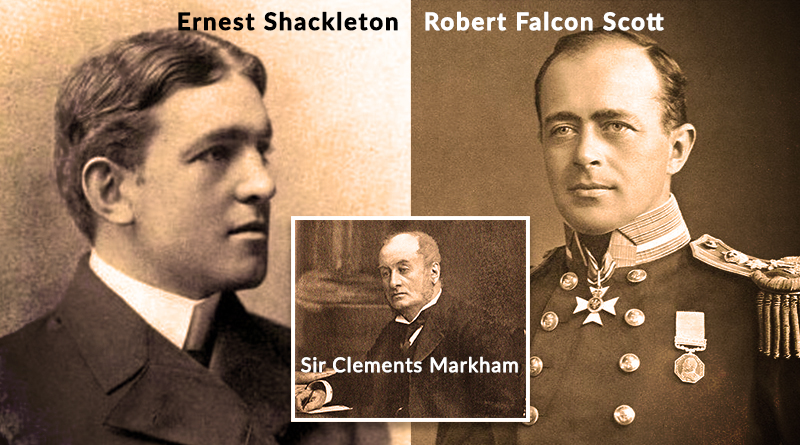We are all familiar with the iconic RRS Discovery, currently berthed as the crown jewel of Dundee’s waterfront. If you don’t know the history of this ship, you can find out all you need to know about its history and its impact on Antarctic whaling here http://www.rrsdiscovery.com – but for now, let’s concentrate on what we’re good at – ramping up the darkness…
It was a dream of Sir Clements Markham to have a British National Antarctica Expedition, a dream that began to be realised when construction on the HMS Discovery began on 16th March 1900 by Dundee Ship Builders Company; but not everyone thought Markham was the perfect gentleman. An educated man with a wealth of naval experience, Markham took a real shine to Robert Falcon Scott, who many firmly believed was his protégé. Ernest Shackleton, however, wasn’t always so fortunate, as we’ll find out a wee bit later.
Forty-nine experienced seamen began their journey in 1901, picked by Scott himself– a real mix of characters – which proved to be a source of deep regret for the Captain. Arguments and fist fights were not uncommon among the rowdy males, enhanced by the cramped and bitter living conditions aboard the ship and further exacerbated by being trapped in Antarctic ice for 2 years before they were blasted free! Sadly, not all of these men would return home, the most tragic case being the death of a young seaman, Charles Bonner, who fell from the main mast on the ship’s departure from Lyttelton (New Zealand). Reports show he fell head first onto the iron deckhouse, smashing his skull upon impact. The area where he fell is also a source of alleged paranormal activity.
The Discovery has had its fair share of ghost stories, including sounds and mystery noises coming from the bedroom of Ernest Shackleton, who was named as third officer aboard the ship during the time of Captain Scott’s expedition, and who went on to lead 3 British expeditions to the Antarctic. He was sent home early on health grounds after a Polar trek went horrifically wrong, killing all 22 sled dogs and afflicted Scott, Shackleton and scientist Edward Wilson with a variety of potentially deadly ailments such as snow blindness, scurvy and frostbite.
“On the return journey, Shackleton had by his own admission “broken down” and could no longer carry out his share of the work…He would later deny Scott’s claim in The Voyage of the Discovery, that he had been carried on the sledge…However, he was in a seriously weakened condition; Wilson’s diary entry for 14 January reads: “Shackleton has been anything but up to the mark, and today he is decidedly worse, very short winded and coughing constantly, with more serious symptoms that need not be detailed here but which are of no small consequence one hundred and sixty miles from the ship”. On 4 February 1903, the party finally reached the ship. After a medical examination (which proved inconclusive), Scott decided to send Shackleton home on the relief ship Morning, which had arrived in McMurdo Sound in January 1903. Scott wrote: “He ought not to risk further hardship in his present state of health.” There is conjecture that Scott’s motives for removing him was resentment of Shackleton’s popularity, and that ill-health was used as an excuse to get rid of him. Years after the deaths of Scott, Wilson and Shackleton, Albert Armitage, the expedition’s second-in-command, claimed that there had been a falling-out on the southern journey, and that Scott had told the ship’s doctor that “if he does not go back sick he will go back in disgrace”.” (en.wikipedia.org)
Having initially agreed to Shackleton’s proposal for leadership of a Polar exploration, Clements Markham changed his mind and began to denounce Shackleton’s credentials, going so far as to cross out credible or favourable entries towards Shackleton in his own notes. Markham’s sudden dismissiveness towards Shackleton is seen by many as a show of resentment, as Markham wished polar glory to be attributed to his protégé, Scott.
Maybe this is the reason people keep hearing noises such as snoring and knocking coming from Shackelton’s room aboard the RRS Discovery to this day – poor Shackleton is still annoyed with Markham after all this time! Whilst people in the past have claimed that Shackleton died aboard the Discover, this is untrue, but does lend itself to the theory that Shackleton’s ghost is responsible for the potential hauntings.
In a bizarre twist of fate for Markham, whilst reading in bed by candlelight, his bed caught fire, and he barely survived, only to die the following day from his injuries on 30th January 1916.
RRS Discovery did a lot more than just sail to the Antarctic a couple of times, enjoying life as a working munitions ship during WWI as well as a training vessel for both the Royal Navy & the Seal Scouts (Boy Scouts Association), before finally returning home to Dundee for good in April of 1986. Whilst the Antarctic missions may be the most prominent things in folks mind when attributing ghostly phenomena to the RRS Discovery, it’s worth remembering that she saw a lot more action, and undoubtedly more horrors than we give her credit for.
Why not find out for yourself and take a trip to visit her? Alternatively, you can take a wee virtual tour here http://www.digisurv.co.uk/Discovery/tour.html Who knows what you might uncover?
– DD Tours operates walking tours in Dundee city, covering dark local history such as wars, battles, murders, diseases, riots, disasters and executions. Walk with us for an unforgettable storytelling experience.
OR
